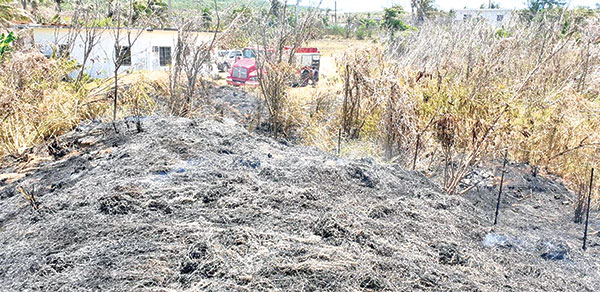Over 10 wildfires in a week

Photo posted by the Department of Fire and Emergency Medical Services on its Facebook page shows one of the seven grass fires reported yesterday. DFEMS said that majority of yesterday’s wildfires occurred on northern side of Saipan. (DFEMS)
In the span of just a week, the Department of Fire and Emergency Medical Services responded to over 10 wildfires across the CNMI.
Wildland fires—also known as brush fires, forest fires, grass fires, etc.—have become rampant in the CNMI, attributed to the Commonwealth’s early transition into a drought season that is being blamed on an early onset of the Pacific-wide El Niño phenomenon.
In the past week alone, the CNMI saw roughly over 10 wildland fires, according to the DFEMS Facebook page.
On Saipan, DFEMS’ wildland fire fighting team responded to about nine wildland fires since last Friday. Wildland fires were seen in Kagman, Tanapag, As Gonno, As Terlaje, near Banzai Cliff, and near Paupau beach.
There have also been two wildland fires on Rota throughout the course of the week and about two on Tinian.
Yesterday alone, seven wildland fires erupted across Saipan—from Kagman all the way down to As Gonno. As of 6:40 last night, one of the bigger fires in Tanapag had not been contained yet and was last reported moving toward Wireless Ridge, an area that is notorious for grass fires.
In a previous article on the Saipan Tribune, it stated that the dry season is expected to last until May.
In the past month, prior to the eruption of wildland fires this past week, the DFEMS fought and contained over seven wildland fires on the islands of Saipan and Tinian.
Fortunately, according to DFEMS spokesperson Derek Gersonde, the CNMI has a team of seasoned wildland fire fighters.
Gersonde explains that wildland fires are fought differently than structure fires, which are primarily extinguished with water.
Wildland firefighters, however, are trained to use tools such as rakes, shovels, etc., to contain wildland fires from extending further out and to make the right calls whether the fire should be put out with water or if it’s safe to let the fire continue to burn because it won’t harm crops or structures and is on its way dying out on its own.
Wildland fires are a relatively normal occurrence during the islands’ dry season.























